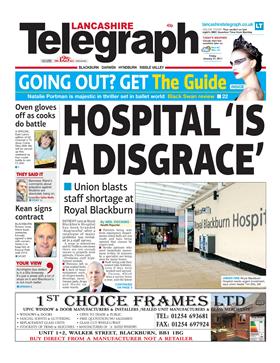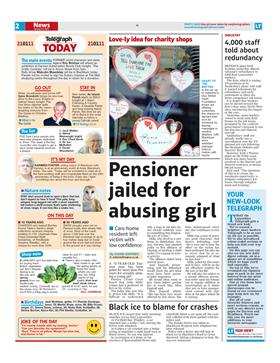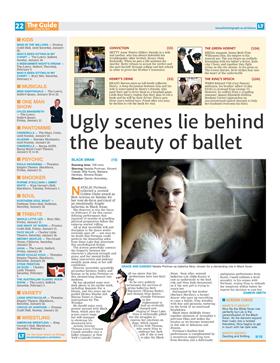The newspaper I did most of my training on, and spent five years working on during two spells, unveiled a new look on Friday. It hit the streets at 7am. By 10am, Roy Greenslade had delivered a withering verdict on the redesign.
I hate to rain on the Telegraph’s parade, but the sight of this “new” front page is hardly encouraging. The predictable choice of splash and its presentation suggests to me a major reason for the decline in popularity of regional (and local) newspapers.I realise that concerns about the grooming of young girls is a topical story, especially in certain towns in Lancashire. But the tabloid-style treatment is surely inappropriate in a paper that is supposed to appeal to a wide cross-section of the residents of Blackburn, Burnley and their hinterlands.Why should a regional papers think a huge sans headline over a crime story with very little text is “modern” and exciting? Then there is the inevitable celebrity content.
It’s not bad going to have either got up from London to review the edition or to have arranged with Newsquest, not the most talkative of newspaper publishers, to have a copy sent to him for an early critique. That is, of course, assuming Greenslade – whose blog I enjoy reading, even if I don’t always agree with it – has seen the entire edition and not just the small images posted on the Lancashire Telegraph website to accompany the announcement about the relaunch.
For what it’s worth – and I’m certainly not a design expert – I disagree with Prof Greenslade’s assessment of the new-look Lancashire Telegraph. The reason I disagree isn’t based on any journalistic insight but on the fact that when I went into my local Tesco, which sells three daily regional newspapers, the Telegraph stood out much more than usual.
My local Tesco sells both editions of the Lancashire Telegraph and I tend to read the Blackburn edition, not the Burnley edition, which is the one Greenslade draws his conclusions from. Yes, the new design is very tabloid, but it’s also very busy, selling very hard the content inside. The Blackburn edition led on a hospital staff survey it had got its hands on – a worrying read for anyone who goes to the hospital, and the latest in a catalogue of bad news stories from the local hospital trust.
The splash on the Burnley edition which Greenslade refers to was headlined ‘Terror of Predator’ and was an interview with a mum who discovered a man was grooming her teenaged son online via Facebook. It’s a good read and isn’t what I’d call predictable. To that end, Greenslade’s suggestion ‘I realise that concerns about the grooming of young girls is a topical story, especially in certain towns in Lancashire‘ doesn’t really make sense, as it was teenage boy being groomed via Facebook. The topicality of grooming of young girls is something the Lancashire Telegraph has led on for several years – Jack Straw’s recent comments about Pakistani gangs may have caused a surprise nationally, but the Telegraph played a big part in raising the issue and drawing attention to it four years ago – and work with the police to tackle it too.
So the main argument from Greenslade appears to be that tabloid design is in part to blame for the decline of regional newspapers, along with the tabloid treatment they give to stories. If anything, I think the industry is guilty of putting too much emphasis on design. We can all name newspapers which are very poor on design but which enjoy considerable success.
Will a reader really refuse to buy a paper because the headline is a little too full on? Having covered some very high-profile stories in the Ribble Valley – the poshest part of the Telegraph’s patch – which were given a tabloid treatment and still contributed strong sales days, I suggest the answer is no.
That leads me to the conclusion that it’s content which counts. In the case of the Lancashire Telegraph, it’s the only product providing a daily news and sports mix which caters for East Lancashire.
It does so, like every other regional newspaper, in an era where the loyal, six-day-a-week reader is harder to come by. This is, in part, due to the decline of the newsagent. Supermarkets play a massive part in the success or failure of circulation strategies now and newspapers need to grab attention quickly – and that’s what the Telegraph’s new design does. Regional newspapers have to shout to show what they’ve got, or do something which makes the passing customer stop and take note.
Steve Dyson, the former Birmingham Mail editor, is a massive fan of the Lancashire Telegraph – he praised it last year for editionising so heavily (something which was at times a considerable chore when working on the LET – as it was then – newsdesk). It tries to get as local as possible and get as much in as possible, and the inside pages, in my opinion, combine high story counts without sacrificing design. It applies that principle to the front page too – providing as many reasons to buy the paper as possible.
Greenslade also argues that the paper shouldn’t be promoting a film review of Black Swan, claiming:
“Why should the people of Bacup, Darwen and Oswaldtwistle be especially interested in the movie Black Swan? That’s a national, not a regional, feature.”
Here’s a thought: We have cinemas in East Lancashire, too. In fact, in recent years, two new multiplexes have opened. Cinema going is a major past-time in the area, so it figures that promoting a film review is a sensible thing to do.
Greenslade concludes by saying:
Of course, it’s foolish to compare that figure to the Evening Telegraph’s sales during my time as a sub there (under the wonderful Harry Childs – anyone else remember him?) in 1967-8. Even so, we must have been doing something right with our much more sober editorial approach in those days.
Yes, the only thing which was different back in 1967 in East Lancashire was the more sobre approach the Evening Telegraph took to its news coverage. Changing consumer habits, more transisent communities, greater availability of news … none of those have had any impact at all. Life here really is just like the whimsical view of the north delivered by The Guardian’s Northerner column on a regular basis. Such an argument would have currency if those papers which do look very similar to their 1960s counterparts in look and tone were as popular as ever, but that simply isn’t true.
I agree with Roy that a redesign alone won’t reverse a circulation decline – but if it helps draw attention from the lapsed reader and facilitates higher story count and the ability to deliver the content readers want, then it certainly can’t hurt. And I say that as someone who has bought and read the whole paper.





No comments:
Post a Comment